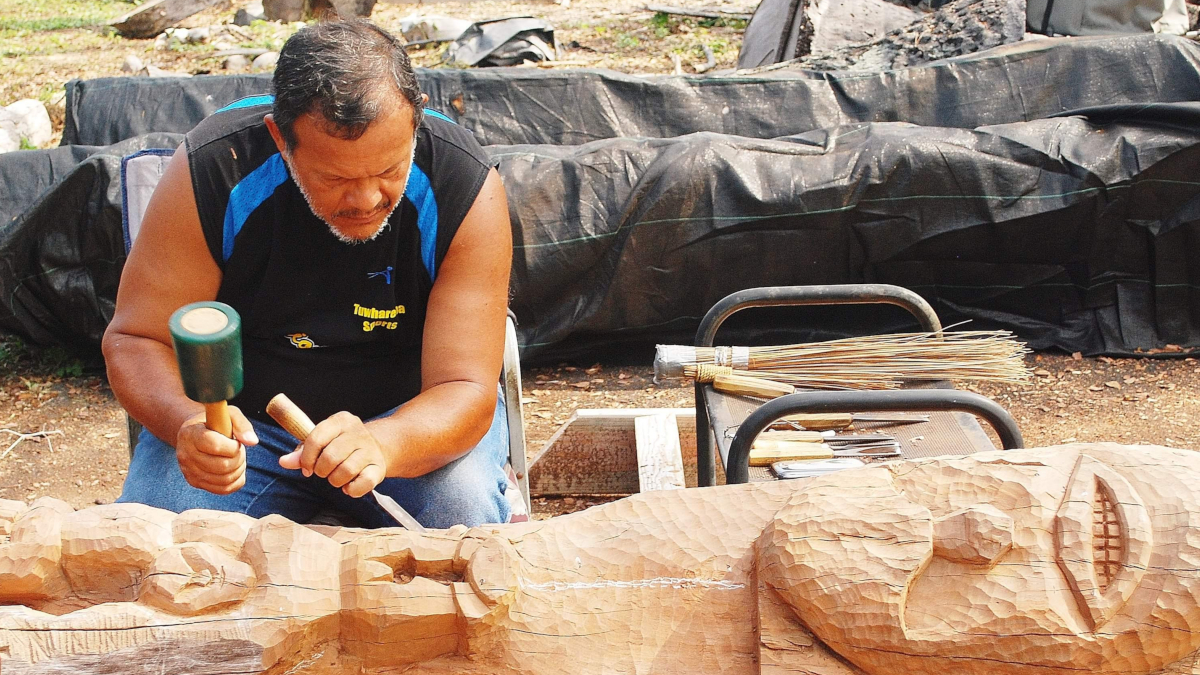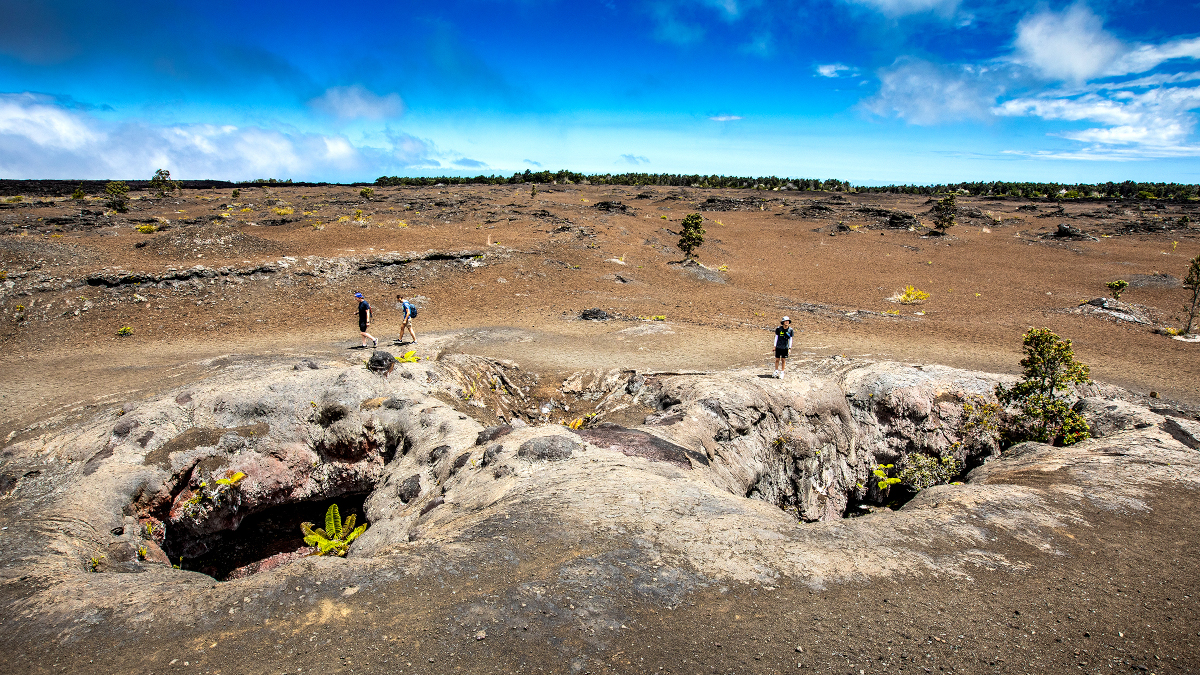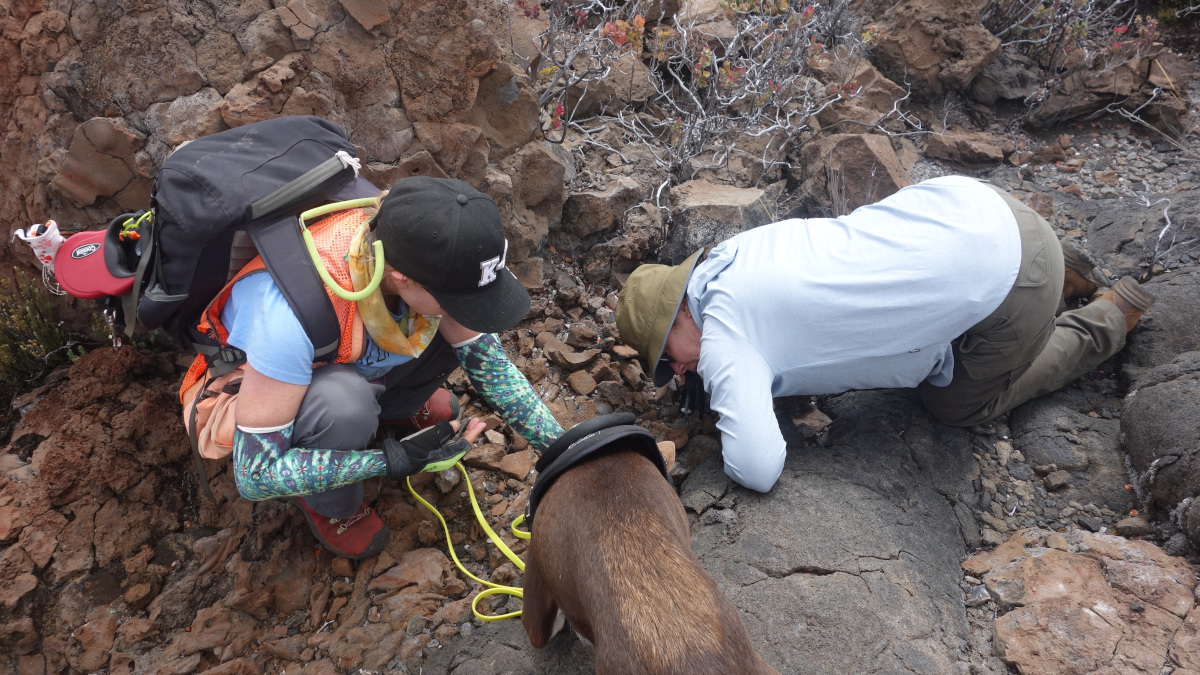(BIVN) – January and February 2023 will be busy months for activites at Hawaiʻi Volcanoes National Park.
The National Park Service has released a schedule of events for the first two months of the new year, and noted that January is also Volcano Awareness Month. The park is hosting three programs by USGS Hawaiian Volcano Observatory scientists, after dark and in broad daylight.
All events are free, but entrance fees may apply.
The following schedule information was provided by the National Park Service:
ʻIke Hana Noʻeau Hawaiian Cultural Demonstrations are Back! Learn to create beautiful designs with traditional patterns using ‘ohe kāpala (bamboo stamps). Originally used to decorate clothing with deep symbolic meanings, we now use the designs on ‘ohe kāpala to tell stories on a variety of modern materials. Bring your own bag or t-shirt and stamp away. Part of Hawaiʻi Volcanoes National Park’s ongoing ‘Ike Hana Noʻeau (Experience the Skillful Work) Hawaiian cultural programs.
When: Wednesday, January 11 from 10 a.m. to noon
Where: ʻŌhiʻa Wing (across Crater Rim Drive from Kīlauea Visitor Center)
Fee-Free Day on Martin Luther King, Jr. Day. All fee-charging national parks including Hawaiʻi Volcanoes National Park are free in honor of the legacy of Dr. Martin Luther King, Jr.
When: Monday, January 16
Where: All fee-charging national parks in the U.S.
Liliʻuokalani at Washington Place. January 17 marks the anniversary of the illegal overthrow of the Hawaiian Kingdom in 1893. The park presents an amazing one-woman show written and performed by Jackie Pualani Johnson who reenacts the Queen’s remembrance and the solace she found in family after the overthrow of her kingdom. Jackie Pualani Johnson developed her portrayal from the writings of Queen Liliʻuokalani, the Queen’s family and other historical sources. Part of Hawai‘i Volcanoes’ ongoing After Dark in the Park programs.
When: Tuesday, January 17 at 7 p.m.
Where: Kīlauea Visitor Center auditorium
Kahuku Coffee Talk: Waʻa Lashing & Cordage. James Akau, lifelong Kaʻū community member, sailor and ʻāina enthusiast shares his knowledge of Hawaiian cordage and how it was used for lashing on Hawaiian waʻa (outrigger canoes). James has been a ship engineer and scientific diver. Part of Hawaiʻi Volcanoes’ ongoing Kahuku Coffee Talk programs.
When: Saturday, January 21 at 9:30 a.m.
Where: Kahuku Visitor Contact Station
Volcano Awareness Month began on the Island of Hawai‘i in 2010. During the month of January, the USGS Hawaiian Volcano Observatory, in cooperation with Hawai‘i Volcanoes National Park and other partners, promotes the importance of understanding and respecting the volcanoes on which we live through community talks and guided walks. You are invited to the following programs in your park:
Hike Back in Time to the 1969-74 Maunaulu Eruption. USGS Hawaiian Volcano Observatory Geologist Dr. Carolyn Parcheta leads a two-hour guided walk along the fissure that stared the Maunaulu eruption on May 24, 1969. Lava continued to erupt over the next five years, making it the longest observed effusive rift eruption of the time. The eruption ultimately built a lava shield, Maunaulu (growing mountain), a prominent landmark on Kilauea volcano’s East Rift Zone. It also sent lava flows to the coast and allowed for detailed observations of eruption processes. During the walk, Carolyn will describe how fissures form, how lava fountains erupt, how these eruptions create the environments you see and why some lava drained back into the ground. Bring sun protection, rain gear, day pack, snacks and water. Part of the USGS Volcano Awareness Month programs.
When: Sunday, January 22 at 10 am. or 2 p.m.
Where: Meet at the Maunaulu parking lot prior to the hike start time
Insights from the First Mauna Loa Eruption in Nearly 40 Years. After 38 years of quiesence, Mauna Loa erupted from November 27 through December 10, 2022. The eruption began in the summit caldera and within a day had migrated to the Northeast Rift Zone. Lava flows moved downslope on the northeast flank but eventually stalled before impacting a major highway. Join Matt Patrick and Mike Zoeller, geologists with the USGS Hawaiian Volcano Observatory, as they describe this historic eruption and what we’ve learned from it. Part of the USGS Volcano Awareness Month and After Dark in the Park series.
When: Tuesday, January 24 from 7 p.m. to 8 p.m.
Where: Kīlauea Visitor Center auditorium
Changes at the Summit of Kīlauea After 2018. In 2018, the lava lake within Halemaʻumaʻu crater drained and the caldera floor dropped by more than 1,600 feet (500 m). There has been a variety of activity within Halemaʻumaʻu since then. The first-ever documented water lake filled the bottom of the crater starting in summer 2019. It reached approximately 160 feet (50 m) deep before Kīlauea started erupting again in December 2020. This eruption continued until May 2021. Kilauea was again quiet for about three months before it burst to life in September 2021. That eruption continued until December 2022. USGS Hawaiian Volcano Observatory Geologist Drew Downs recounts these events and how the USGS Hawaiian Volcano Observatory continues to monitor activity at this extraordinary volcano. Part of the USGS Volcano Awareness Month and After Dark in the Park series.
When: Tuesday, January 31 from 7 pm. to 8 p.m.
Where: Kīlauea Visitor Center auditorium
ONGOING PROGRAMS
Explore Kahuku. The Kahuku Unit, one of Hawai‘i Volcanoes National Park’s best-kept secrets, is open Thursday through Sunday from 8 a.m. to 4 p.m., and it’s free! Guided ranger programs and talks are offered on the weekends, check the park calendar for more info. Sturdy footwear, water, rain gear, sun protection and a snack are recommended for all hikes.
When: Thursday through Sunday, 8 a.m. to 4 p.m. Note: Kahuku is closed New Year’s Day.
Where: Kahuku is located in Ka‘ū, and is about a 50-minute drive south of the park’s main entrance. Enter Kahuku on the mauka (inland) side of Highway 11 near mile marker 70.5.
A Walk into the Past with Dr. Thomas A. Jaggar. Walk back to 1939 and talk with the founder of the Hawaiian Volcano Observatory, Dr. Thomas A. Jaggar, at the edge of Kīlauea volcano. Dressed in period costume, actor Dick Hershberger brings the renowned geologist to life. You’ll learn what motivated Dr. Jaggar to dedicate his life to the study of Hawaiian volcanoes, and how his work helps save lives today. Space is limited; pick up a free ticket at the Kīlauea Visitor Center lānai the day of the program. Supported by Kīlauea Drama Entertainment Network.
When: Fridays, January 6, 13, 20 & 27 at 10 a.m. and noon. Each performance is about an hour.
Where: Meet at Kīlauea Visitor Center
Stewardship at the Summit Rainforest Restoration. Volunteer to help remove invasive, non-native plant species that prevent native plants from growing in Hawai‘i Volcanoes National Park. Wear sturdy hiking shoes and long pants. Bring a hat, rain gear, day pack, snacks and water. Gloves and tools are provided. Under 18? Parental or guardian accompaniment with written consent is required. Visit the park website for details.
When: January 7, 13, 21 & 27. Meet at 8:45 a.m.
Where: Meet project leaders Paul and Jane Field at Kīlauea Visitor Center on any of the above dates.
Explore the Summit and Other Ranger-Led Walks. Discover Kīlauea volcano on an easy one-hour, ranger-led walk offered daily. Other ranger-led programs may be offered; check with rangers at Kīlauea Visitor Center for additional programs.
When: Explore the Summit is offered daily at 11 a.m. and 2 p.m.
Where: Meet at Kīlauea Visitor Center lānai
Monitoring Seabirds in Hawaiʻi Volcanoes National Park. The ʻuaʻu (Hawaiian petrel) and the ʻakēʻakē (band-rumped storm petrel) are seabirds that spend most of their lives on the open ocean, coming to land only to breed. These endangered species nest in burrows on the barren lava flows of Mauna Loa within the park. Join Charlotte Forbes Perry, biologist with the University of Hawaiʻi Pacific Cooperative Studies Unit and Dr. Michelle Reynolds and Slater of Hawaiʻi Detector Dogs to share what they found during the 2022 seabird monitoring system. Part of Hawai‘i Volcanoes’ ongoing After Dark in the Park programs.
When: Tuesday, February 7 at 7 p.m.
Where: Kīlauea Visitor Center auditorium
Learn to Carve Hawaiian-Style. Hawaiians carved kiʻi (statues) to represent forces of nature, guardians and the spirit world. Acclaimed artist James Kanani Kaulukukui Jr., who has worked on the sacred site of Ke Kahua O Kaneiolouma Heiau on Kauaʻi, will share his expertise and the essential role kiʻi played in Hawaiian society. Part of Hawaiʻi Volcanoes National Park’s ongoing ‘Ike Hana Noʻeau (Experience the Skillful Work) Hawaiian cultural programs.
When: Wednesday, February 8 from 10 a.m. to noon
Where: ʻŌhiʻa Wing (across Crater Rim Drive from Kīlauea Visitor Center)
Virtual Visit to Papahānaumokuākea National Marine Monument. Papahānaumokuākea is the single largest, fully protected conservation area on Earth as well as a UNESCO World Heritage Site. This protected area is critical habitat for endangered Hawaiian monk seals, threatened Hawaiian green sea turtles, and over 14 million seabirds. Native Hawaiian cultural reconnection with these islands, and active leadership in management, has also ensured this protection is lasting. Join Andy Collins, Education Coordinator with the Mokupāpapa Discovery Center, as we take a virtual visit to this amazing and remote part of Hawaiʻi, hear how it’s managed, and see what lies ahead. Part of Hawai‘i Volcanoes’ ongoing After Dark in the Park programs.
When: Tuesday, February 14 at 7 p.m.
Where: Kīlauea Visitor Center auditorium
Ben Kaʻili in Concert. Come enjoy Hilo’s own Hawaiian slack key guitarist and three-time Nā Hōkū Hanohano award winner Ben Kaʻili and friends in concert. Part of Nā Leo Manu (Heavenly Voices of Hawaiian music) concerts and presentations at Hawaiʻi Volcanoes National Park.
When: Wednesday, February 15 from 7 p.m. to 8 p.m.
Where: Kīlauea Visitor Center auditorium
Kahuku Coffee Talk: Anchialine Pools. Anchialine pools host one of the rarest ecosystems on earth, yet few people have ever heard of them. Hawai‘i Island is home to approximately 650 of the estimated 700 or so anchialine pools in the state. Join Aquatic Biologist Anne Farahi along with Park Ranger Dean Gallagher on a virtual visit into this hidden realm and meet the charming and endemic ʻōpaeʻula, a tiny shrimp. Part of Hawaiʻi Volcanoes’ ongoing Kahuku Coffee Talk programs.
When: Saturday, February 18 at 9:30 a.m.
Where: Kahuku Visitor Contact Station
ONGOING PROGRAMS
Explore Kahuku. The Kahuku Unit, one of Hawai‘i Volcanoes National Park’s best-kept secrets, is open Thursday through Sunday from 8 a.m. to 4 p.m., and it’s free! Guided ranger programs and talks are offered on the weekends, check the park calendar for more info. Sturdy footwear, water, rain gear, sun protection and a snack are recommended for all hikes.
When: Thursday through Sunday, 8 a.m. to 4 p.m.
Where: Kahuku is located in Ka‘ū, about a 50-minute drive south of the park’s main entrance. Enter Kahuku on the mauka (inland) side of Highway 11 near mile marker 70.5.
A Walk into the Past with Dr. Thomas A. Jaggar. Walk back to 1939 and talk with the founder of the Hawaiian Volcano Observatory, Dr. Thomas A. Jaggar, at the edge of Kīlauea volcano. Dressed in period costume, actor Dick Hershberger brings the renowned geologist to life. You’ll learn what motivated Dr. Jaggar to dedicate his life to the study of Hawaiian volcanoes, and how his work helps save lives today. Space is limited; pick up a free ticket at the Kīlauea Visitor Center lānai the day of the program. This program is subject to cancellation during inclement weather. Supported by Kīlauea Drama Entertainment Network.
When: Fridays, February 3, 10, 17 & 24 at 10 a.m. and noon. Each performance is about an hour.
Where: Meet at Kīlauea Visitor Center
Stewardship at the Summit Rainforest Restoration. Volunteer to help remove invasive, non-native plant species that prevent native plants from growing in Hawai‘i Volcanoes National Park. Wear sturdy hiking shoes and long pants. Bring a hat, rain gear, day pack, snacks and water. Gloves and tools are provided. Under 18? Parental or guardian accompaniment with written consent is required. Visit the park website for details.
When: February 4, 10, 17 & 25. Meet at 8:45 a.m.
Where: Meet project leaders Paul and Jane Field at Kīlauea Visitor Center on any of the above dates.
Explore the Summit and Other Ranger-Led Walks. Discover Kīlauea volcano on an easy one-hour, ranger-led walk offered daily. Other ranger-led programs may be offered; check with rangers at Kīlauea Visitor Center for additional programs.
When: Explore the Summit is offered daily at 11 a.m. and 2 p.m.
Where: Meet at Kīlauea Visitor Center lānai




by Big Island Video News3:48 pm
on at
STORY SUMMARY
HAWAIʻI VOLCANOES NATIONAL PARK - The National Park Service has scehduled two months of events at the park to start the year 2023.